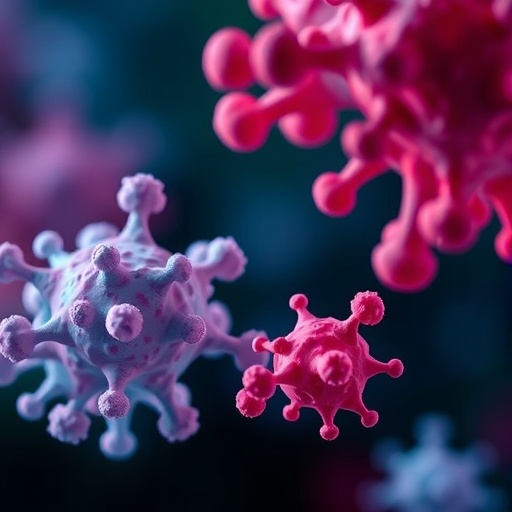
In a groundbreaking multicenter study conducted across China, researchers have unveiled new insights into the safety and quality of life experienced by patients undergoing CDK4/6 inhibitor therapy for hormone receptor-positive, HER2-negative advanced breast cancer. This pivotal survey, encompassing over 1,200 patients, sheds light on the complex interplay between treatment efficacy, adverse effects, and the lived realities of those confronting this challenging disease. As CDK4/6 inhibitors become cornerstone treatments in oncology, understanding their nuanced impact on patients is paramount.
Cyclin-dependent kinase 4 and 6 (CDK4/6) inhibitors have revolutionized the therapeutic landscape for hormone receptor-positive (HR+), human epidermal growth factor receptor 2-negative (HER2-) advanced breast cancer. These agents function by impeding cell cycle progression, thereby restraining the proliferation of malignant cells. Despite their clinical promise, concerns about the spectrum and severity of adverse events (AEs) that accompany their use persist, alongside questions regarding their influence on patients’ quality of life.
This extensive cross-sectional survey involved a cohort of 1,254 patients currently receiving CDK4/6 inhibitor therapy, aiming to elucidate real-world treatment patterns and associated toxicities in the Chinese healthcare setting. Patients self-reported adverse symptoms and quality of life metrics using validated questionnaires, including the European Organisation for Research and Treatment of Cancer’s breast cancer-specific quality of life instrument, the EORTC QLQ-BR23. Concurrently, oncologists provided detailed clinical data extracted from medical records, enabling a comprehensive synthesis of patient experience and clinical observation.
The study revealed that the majority of patients were treated with a single CDK4/6 inhibitor. Dalpiciclib emerged as the most commonly administered agent, accounting for nearly 39% of cases, closely followed by abemaciclib and palbociclib at approximately 36% and 15%, respectively. Ribociclib usage was minimal in this cohort. Notably, a subset of patients sequentially received two different CDK4/6 inhibitors, reflecting evolving treatment strategies and potential resistance management protocols within clinical practice.
Adverse events were prevalent, with over 81% of patients experiencing some form of toxicity during therapy. Hematologic toxicities dominated the spectrum, with leukopenia and neutropenia affecting more than half of the cohort. These findings underscore the immunosuppressive consequences of CDK4/6 inhibition, necessitating vigilant blood count monitoring and supportive interventions in routine care. Such high incidences of these hematological adverse effects call attention to the delicate balance clinicians must maintain between anticancer efficacy and patient safety.
Patient-reported side effects painted a somewhat different, yet equally critical, picture. Fatigue was the most frequently cited symptomatic complaint, reported by over one-third of respondents, followed by alopecia and generalized weakness. The subjective burden of these symptoms often extends beyond measurable clinical parameters, profoundly influencing daily functioning and psychosocial well-being. Fatigue, in particular, is a multifactorial phenomenon in oncology patients, linked to both disease burden and treatment toxicity.
Intriguingly, the incidence of alopecia—a distressing and visible side effect impacting body image—varied significantly among the different CDK4/6 inhibitors. Patients receiving dalpiciclib reported substantially lower hair loss rates compared to those on palbociclib and abemaciclib. This disparity suggests differing mechanistic toxicities or pharmacodynamic profiles among these agents, influencing patient acceptance and adherence. Understanding such variations can guide personalized treatment selection tailored to patient preferences and quality of life considerations.
Quality of life analyses revealed nuanced differences between treatment groups. Palbociclib-treated patients exhibited lower breast symptom scores relative to those administered abemaciclib, suggesting differential impacts on localized symptomatology and possibly tolerability. This observation aligns with evolving evidence suggesting that even within the same drug class, distinct inhibitors may differ in side effect profiles, potentially mediated by tissue-specific drug distribution or off-target effects.
Further analyses established correlations between alopecia and multiple quality of life domains, including body image, systemic therapy side effects, breast-specific symptoms, arm symptoms, and psychological distress prompted by hair loss. These associations emphasize that alopecia is more than a cosmetic concern; it intertwines with mental health and social identity, influencing treatment experience and outcomes in a profound manner. Such insights call for integrated supportive care approaches addressing both physical and emotional dimensions.
The researchers conclude that despite the established efficacy of CDK4/6 inhibitors in HR+/HER2- advanced breast cancer, their safety profiles differ and exert variable influences on patient quality of life. These findings highlight an urgent clinical imperative to personalize treatment strategies, balancing potent anticancer activity with tolerability and patient-centered care. As the therapeutic armamentarium expands, incorporating patient-reported outcomes into clinical decision-making will be critical.
This study’s robust methodology, combining physician assessments and patient self-reports, offers a comprehensive and multidimensional understanding of CDK4/6 inhibitor therapy in a real-world context. It brings to light not only clinical toxicities but also the subjective experiences shaping treatment adherence and satisfaction. Such patient-centric evidence is invaluable for oncology practitioners striving for holistic cancer care.
Moreover, the research underscores the importance of cultural and demographic considerations in oncology. Conducted within a Chinese population, these data contribute to a more global perspective on CDK4/6 inhibitor therapy, acknowledging potential ethnic and healthcare system variations affecting treatment patterns and outcomes. Such diversity in research cohorts enhances the external validity of clinical findings.
Looking forward, these insights lay the groundwork for prospective studies investigating mechanisms underlying differential toxicity profiles and quality of life impacts among CDK4/6 inhibitors. Future research might explore pharmacogenomic markers predicting susceptibility to specific adverse events, enabling precision medicine approaches. Additionally, interventional trials targeting symptom management strategies could mitigate the burden of fatigue, alopecia, and other debilitating side effects.
Healthcare providers should heed these findings by integrating routine quality of life assessments into clinical visits and fostering open communication about adverse symptoms. Education on managing common toxicities and proactive supportive care can empower patients and enhance therapeutic tolerability. Multidisciplinary collaboration among oncologists, nurses, and psychosocial specialists will be vital in this endeavor.
In summary, this landmark survey articulates the dual reality confronting patients on CDK4/6 inhibitor therapy: substantial clinical benefits juxtaposed with diverse and sometimes onerous adverse effects influencing quality of life. By illuminating these dynamics, the study paves the way for optimized, empathetic cancer care that honors both survival and the lived experiences of patients battling advanced breast cancer.
—
Subject of Research: Safety and quality of life associated with CDK4/6 inhibitor therapy in hormone receptor-positive, HER2-negative advanced breast cancer patients.
Article Title: Safety and quality of life of CDK4/6 inhibitors therapy for hormone receptor-positive, human epidermal growth factor receptor 2-negative advanced breast cancer: a multicenter cross-sectional survey in China.
Article References: Yang, B., Sun, Z., Ouyang, Q. et al. Safety and quality of life of CDK4/6 inhibitors therapy for hormone receptor-positive, human epidermal growth factor receptor 2-negative advanced breast cancer: a multicenter cross-sectional survey in China. BMC Cancer 25, 951 (2025). https://doi.org/10.1186/s12885-025-14223-8
Image Credits: Scienmag.com
DOI: https://doi.org/10.1186/s12885-025-14223-8
Tags: adverse effects of CDK4/6 inhibitorscancer patient self-reporting metricscancer treatment patient experiencesCDK4/6 inhibitors safety studycell cycle progression inhibitorsChinese healthcare and oncologyHER2-negative advanced breast cancer therapyhormone receptor-positive breast cancer treatmentimplications of CDK4/6 therapy in oncologymulticenter study on cancer therapiespatient quality of life on cancer treatmentreal-world data on cancer treatments



